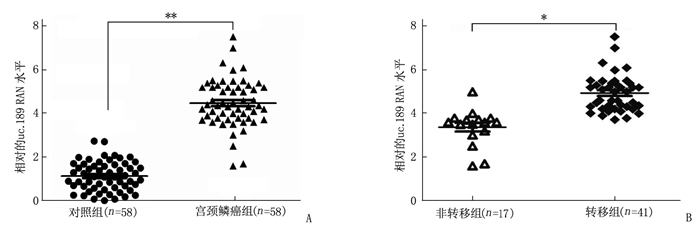Expression of uc.189 exosomes in cervical carcinoma and its clinicopathological significance
-
摘要:目的 检测uc.189在宫颈鳞癌中的RNA表达水平,观察uc.189外泌体的数量及其与临床的病理意义。方法 应用实时荧光定量PCR(qRT-PCR)检测uc.189在58例宫颈鳞癌和癌旁正常组织中的RNA表达水平,电镜下观察宫颈鳞癌组织中uc.189外泌体的数量,并分析其与宫颈鳞癌患者病理参数的相关性。结果 uc.189在宫颈鳞癌组织中的表达水平高于癌旁正常组织,差异有统计学意义(P < 0.05)。肿瘤组织中高含量的uc.189外泌体与宫颈鳞癌的分化程度、淋巴结转移和TNM分期均密切相关(P < 0.05)。结论 uc.189可能是一种宫颈癌的新促癌基因,其可通过外泌体形式参与宫颈鳞癌的发生、发展和转移过程。Abstract:Objective To detect the RNA expression level of uc.189 in cervical squamous cell carcinoma, and to observe the number of exosomes of uc.189 as well as its clinicopathological significance.Methods Quantitative real-time polymerase chain reaction (qRT-PCR) was used to detect the expression of uc.189 RNA in 58 cases of cervical squamous cell carcinoma and adjacent normal tissues. The number of uc.189 exosomes in cervical squamous cell carcinoma was observed under electron microscope, and the correlation between the number of uc.189 exosomes and pathological parameters of cervical squamous cell carcinoma was analyzed.Results The expression level of uc.189 in the cervical squamous cell carcinoma was significantly higher than that in the adjacent normal tissues (P < 0.05). The high number of uc.189 exosomes in tumor tissue was all closely related to the differentiation degree, lymph node metastasis and TNM stage of cervical squamous cell carcinoma (P < 0.05).Conclusion The uc.189 may be a new oncogene of cervical cancer. The uc.189 promotes the occurrence, development and metastasis of cervical squamous cell carcinoma through exosome.
-
-
表 1 荧光定量引物信息表
引物名称 引物序列(5′-3′) uc.189 F: GATGGTTGTACTGATGGC R: TGGTCACATGACGCTGAA U6 F: CGCTTCGGCAGCACATATAC R: TTCACGAATTTGCGTGTCAT 表 2 宫颈鳞癌组织中uc.189外泌体的含量及其意义(x±s)
临床病理参数 高含量组
(n=39)低含量组
(n=19)χ2 P值 患者年龄 <55岁 18 10 0.215 0.781 ≥55岁 21 9 HPV感染 有 15 5 0.834 0.397 无 24 14 肿瘤大小 <3 cm 12 11 1.988 0.252 ≥3 cm 27 8 分化程度 高~中 10 13 9.771 0.004 低 29 6 淋巴结转移 阳性 30 4 16.441 0.001 阴性 9 15 TNM分期 Ⅰ~Ⅱ 8 12 10.284 0.003 Ⅲ~Ⅳ 31 7 -
[1] SIEGEL R L, MILLER K D, JEMAL A. Cancer statistics, 2019[J]. CA: a Cancer J Clin, 2019, 69(1): 7-34. doi: 10.3322/caac.21551
[2] WANG L, WANG X C, LI X Y, et al. Expression of uc. 189 and its clinicopathologic significance in gynecological cancers[J]. Oncotarget, 2018, 9(7): 7453-7463. doi: 10.18632/oncotarget.23761
[3] GUO Y, WANG C H, MIAO X, et al. Upregulation of uc. 189in patients with esophageal squamous cell carcinoma and its clinicopathologic value[J]. Pathol Res Pract, 2017, 213(11): 1400-1403. doi: 10.1016/j.prp.2017.09.005
[4] ZHOU C F, MA J, HUANG L, et al. Cervical squamous cell carcinoma-secreted exosomal mi R-221-3p promotes lymphangiogenesis and lymphatic metastasis by targeting VASH1[J]. Oncogene, 2019, 38(8): 1256-1268. doi: 10.1038/s41388-018-0511-x
[5] ALENQUER M, AMORIM M J. Exosome biogenesis, regulation, and function in viral infection[J]. Viruses, 2015, 7(9): 5066-5083. doi: 10.3390/v7092862
[6] MATHIVANAN S, JI H, SIMPSON R J. Exosomes: Extracellular organelles important in intercellular communication[J]. JProteom, 2010, 73(10): 1907-1920.
[7] SIMPSON R J, LIM J W, MORITZ R L, et al. Exosomes: proteomic insights and diagnostic potential[J]. Expert Rev Proteomics, 2009, 6(3): 267-283. doi: 10.1586/epr.09.17
[8] VALADI H, EKSTRÖM K, BOSSIOS A, et al. Exosome-mediated transfer of m RNAs and micro RNAs is a novel mechanism of genetic exchange between cells[J]. Nat Cell Biol, 2007, 9(6): 654-659. doi: 10.1038/ncb1596
[9] PICCIN A, MURPHY W G, SMITH O P. Circulating microparticles: pathophysiology and clinical implications[J]. Blood Rev, 2007, 21(3): 157-171. doi: 10.1016/j.blre.2006.09.001
[10] HOSSEINI M, KHATAMIANFAR S, HASSANIAN S M, et al. Exosome-encapsulated micro RNAs as potential circulating biomarkers in colon cancer[J]. Curr Pharm Des, 2017, 23(11): 1705-1709. doi: 10.2174/1381612822666161201144634
[11] TOMASETTI M, LEE W, SANTARELLI L, et al. Exosomederived micro RNAs in cancer metabolism: possible implications in cancer diagnostics and therapy[J]. Exp Mol Med, 2017, 49(1): e285. doi: 10.1038/emm.2016.153
[12] SUNG B H, WEAVER A M. Exosome secretion promotes chemotaxis of cancer cells[J]. Cell Adh Migr, 2017, 11(2): 187-195. doi: 10.1080/19336918.2016.1273307
[13] FAN Q, YANG L, ZHANG X, et al. The emerging role of exosome-derived non-coding RNAs in cancer biology[J]. Cancer Lett, 2018, 414: 107-115. doi: 10.1016/j.canlet.2017.10.040
[14] MILANE L, SINGH A, Mattheolabakis G, et al. Exosome mediated communication within the tumor microenvironment[J]. J Control Release, 2015, 219: 278-294. doi: 10.1016/j.jconrel.2015.06.029
-
期刊类型引用(16)
1. 陈秋霞. 护士视角下前馈控制理念联合叙事疗法干预对母婴分离住院产妇泌乳状态的影响观察. 现代诊断与治疗. 2022(09): 1412-1414 .  百度学术
百度学术
2. 荣丽,杨雯,王乔凤. 综合医院非精神科住院患者心理状态及应对方式的调查分析. 当代护士(中旬刊). 2020(03): 147-152 .  百度学术
百度学术
3. 何寅钊. 探讨早期护理干预对母婴分离产妇心理状况以及母乳喂养的作用和影响. 人人健康. 2020(06): 133-134 .  百度学术
百度学术
4. 赵梦念. 护理综合护理干预缓解母婴分离产妇焦虑情绪的效果. 现代诊断与治疗. 2020(16): 2669-2670 .  百度学术
百度学术
5. 张雪英,郭新平,冯文娟,郭跃凯,谢甜. 4C延续性护理模式对早产产妇知觉压力及焦虑抑郁的影响. 护理实践与研究. 2020(21): 96-99 .  百度学术
百度学术
6. 石月姣,李凤玲. 团体人际心理治疗对初产妇产后抑郁症患者临床症状、乳汁分泌、婴儿照顾能力及社会功能的影响. 中国健康心理学杂志. 2019(02): 248-251 .  百度学术
百度学术
7. 甘美英. 认知行为干预及个体化信息支持对早产母婴分离产妇负性情绪及乳汁分泌的影响. 临床合理用药杂志. 2019(09): 157-158 .  百度学术
百度学术
8. 贺曙光,马亚宾. 探究母婴分离早产产妇母乳喂养自我效能与社会支持的关联性. 护理实践与研究. 2019(09): 102-103 .  百度学术
百度学术
9. 张红霞,余丽玲. 可视化宣教缓解初产妇焦虑的效果观察. 临床合理用药杂志. 2019(13): 42-43 .  百度学术
百度学术
10. 廖小沙,胡寿涓,吴梅秀,毛莲芬. 认知行为干预和个体化信息支持对母婴分离产妇负性情绪及乳汁分泌的影响. 内蒙古医学杂志. 2019(05): 632-634 .  百度学术
百度学术
11. 段晶. 护理干预对母婴分离产妇乳汁分泌的影响探讨. 中外女性健康研究. 2019(13): 157+163 .  百度学术
百度学术
12. 叶玉洁. 护理干预对减轻母婴分离早产儿母亲产后焦虑的效果研究. 人人健康. 2019(21): 384 .  百度学术
百度学术
13. 王军. 微信推送对产妇心理状态以及母婴保健知识掌握的影响. 实用临床医药杂志. 2018(08): 92-95 .  本站查看
本站查看
14. 曹巧荣. 系统性护理干预对母婴分离高危妊娠产妇心理和睡眠质量的影响. 临床医学研究与实践. 2018(11): 197-198 .  百度学术
百度学术
15. 郭芹. 信息支持减轻产妇母婴分离焦虑的研究. 当代护士(中旬刊). 2018(12): 52-54 .  百度学术
百度学术
16. 张丽. 母婴分离的高危妊娠产妇心理问题及护理干预. 中国继续医学教育. 2017(33): 155-157 .  百度学术
百度学术
其他类型引用(3)





 下载:
下载:


 苏公网安备 32100302010246号
苏公网安备 32100302010246号